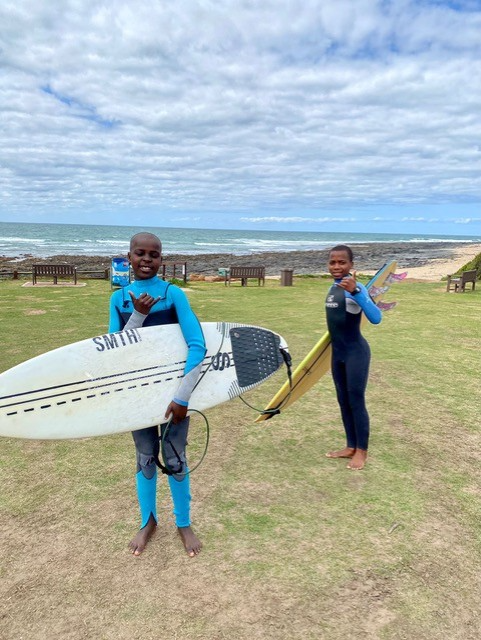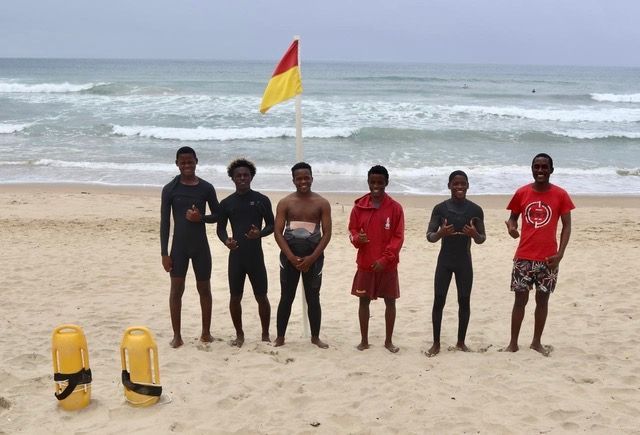A Wave of Change: The Trafalgar Saints Surf Club in South Africa

Funds donated by Cambridge MC supplied some new equipment, including new boards.
Surf for Lives
Royden Bryson, ex professional surfer on the WCT, supported by Mary-Lou Pasquier and Sue-Anne Pearson, has founded a non-profit company dedicated to supporting children in underprivileged communities in South Africa, called Surf for Lives.
The initiative starts with passionate young surfers and culminates in independent adults with sustainable careers.
The mission of Surf for Lives is to provide these children with a safe and nurturing environment where they can enjoy surfing during their youth, while guiding them as they transition into adulthood and explore career opportunities enabled by their ocean-based skills. Surf for Lives continually collaborates with local authorities and organisations to identify diverse pathways to success. These opportunities may include, but are not limited to, lifeguarding, working with the Sharks Board, or joining the South African Marines. The associations unwavering dedication to these children reflects a long-term commitment to fostering positive change. One of the clubs supported by Surf for Lives is the Trafalgar Saints Surf Club, helping children in the Bhokodisa Community, South Africa. We look at the important life-changing activities run by the club and the incredible social impact it creates.
The Trafalgar Saints Surf Club: A Lifeline for Children in the Bhokodisa Community
The Trafalgar Saints Surf Club embodies the profound impact of community and the transformative power of sport. This remarkable charity and surf club serves as a lifeline for approximately 20 to 30 children from the impoverished Bhokodisa community in KwaZulu-Natal, South Africa.
Situated about 150 kilometres south of Durban, near the picturesque main beach of Trafalgar, the club offers far more than just surfing lessons; it provides a sanctuary, mentorship, and pathways to a brighter future. For the past few years the club has been successfully guiding and supporting local children to take part in provincial surfing trials and developing mentorship programmes to assist them in joining the South African Navy. The club's unwavering dedication to these children reflects a long-term commitment to fostering positive change.
Catching a Break
The Trafalgar Saints Surf Club operates as a refuge for the children of the Bhokodisa community, recognised as one of the most impoverished areas along the lower South Coast of KwaZulu-Natal. The children who participate in the club hail from a community beset by violence, substance abuse, and pervasive social challenges.
For these young individuals, the club transcends the role of a mere surf school; it stands as a beacon of hope, a place to learn important skills, build self-confidence and escape the harsh realities of their daily lives.
The club's core mission is to provide comprehensive support through:
- Swimming and Surfing Instruction: The club imparts essential swimming and surfing skills, fostering a vital connection to the ocean and enhancing the children's confidence.
- Mentorship and Guidance: The club offers mentorship on educational aspirations and critical life choices, steering the children towards positive futures.
- Safe and Supportive Environment: The club ensures a secure space where children can spend their time, free from the negative influences that permeate their community.
- Skill Development and Confidence Building: Through various activities, participants cultivate valuable skills and a robust sense of self-worth.
- Creating New Opportunities: The club actively seeks to inspire children to envision and pursue futures that extend beyond their current circumstances.
Maxing out the Impact
The Trafalgar Saints Surf Club profoundly enhances the lives of the children it serves, offering a myriad of opportunities and positive impacts. These include:
- Escape from Adverse Conditions: The club provides a reprieve from the challenges of their impoverished community, offering a day at the beach, away from violence and substance abuse.
- Development of Essential Life Skills: Children learn to swim and surf, gaining confidence and resilience in the ocean while acquiring vital life skills.
- Mentorship and Positive Role Models: Through guidance, children receive support in developing life skills and educational goals, paving the way for a brighter future.
- Pathways to Sustainable Employment: The club encourages members to pursue careers as professional lifesavers, enabling them to support their families and uplift their communities. This opportunity can empower many children to become the primary earners for their households.
- Competitive Surfing Opportunities: The club facilitates participation in provincial surfing trials, instilling goals and a sense of achievement that motivates children to strive for excellence.
- Support to Join the South African Navy: The club assists children in exploring opportunities within the South African Navy, offering further avenues for a promising future. This pathway represents a significant chance for these children to escape seemingly hopeless situations and embrace a new world of opportunity.
Fighting the Tide
Despite its noble mission, the club grapples with substantial challenges, primarily stemming from the severe poverty and scarcity of resources within the Bhokodisa community:
- Limited Access to Resources: The club continually struggles to secure sufficient equipment and surfing accessories for the children, who must make do with what is available.
- Unmet Basic Needs: Many children trek barefoot for 10 to 12 kilometres to reach the beach each weekend, often surfing with minimal food. The club faces ongoing challenges in addressing these basic needs.
- Financial Constraints: Relying on donations and funding, the club must navigate various financial hurdles to sustain its operations and support the children effectively.
Carving Out a Future
The Trafalgar Saints Surf Club collaborates closely with Surf For Lives, a non-profit organisation dedicated to supporting its mission. Additionally, a separate NPO has been established by Royden Bryson, Mary-Lou Pasquier, and Sue-Anne Pearson to raise funds and bolster the club's efforts. There are several meaningful ways for the public to make a tangible difference in the lives of these children.
We list here several ways you can help out today. Please get in touch using the contact form below if you would like to make a donation or find out more.
- Donations for Equipment and Supplies: Urgent funds are needed to purchase surfboards, wetsuits, and other essential gear. Contributions can also help provide basic necessities like food for the children during their time at the beach.
- Long-Term Financial Support: The NPO seeks sustained financial contributions to ensure the club's viability for future generations. Donations can assist with operational costs, including transportation, coaching, and mentoring programmes.
- Awareness Campaigns: Help raise awareness for the club through social media and at the PTC 2025 conference, sharing the stories of these children and the impactful work of the Trafalgar Saints Surf Club.
- Mentorship and Skill Sharing: If you possess relevant experience or skills, consider offering mentorship or training to the children and the club organisers.
Surfs Up
The South African Junior Surfing Championships at Jeffreys Bay
The Trafalgar Saints Surf Club recently participated in the South African Junior Surfing Championships held in Jeffreys Bay from September 24-29th 2024. The competition showcased the talents of young surfers from across the nation, and the club's representatives delivered commendable performances, embracing the competition with gratitude, respect, and enthusiasm.
As the championships concluded, a significant swell arrived on the final evening, prompting the decision to extend their stay. This allowed the boys to experience the renowned waves of Jeffreys Bay during one of the year's best swells—a memorable opportunity that will undoubtedly leave a lasting impression on them.
The success of this trip was made possible through the unwavering support of the Cambridge MC community, whose collective efforts helped create invaluable experiences for the aspiring surfers of the Trafalgar Saints Surf Club.

Thando Sashi (left), Kwanele Sashi (middle), and Okuhle Ngcungama (right) wait for their lift and then make a 12-hour drive to the competition.

Amkela Mgcina (left), Thando Sashi (middle) and Kwanele Sashi (right) get ready to hit the surf.

Thando Sashi (front) and Thando Sashi (back).
Staying in the Pocket
The long-term vision for the Trafalgar Saints Surf Club is to establish a self-sustaining entity capable of supporting children from the Bhokodisa community for generations to come.
The club's strategic plan includes:
- Sustainable Funding: Securing consistent financial support is crucial for the club's ongoing operations and its ability to provide for the children. This includes raising funds to cover equipment costs and basic needs.
- Developing a Robust Mentoring Programme: The club aims to create a structure that provides continuous mentorship and guidance to the children, helping them navigate positive life choices.
- Expanding Employment Pathways: The club seeks to build upon its efforts in encouraging children to become lifesavers and join the South African Navy, thereby broadening their future possibilities.
- Empowering the Community: The club aspires to empower both the children and their community, instilling a belief in their potential to effect positive change in their lives.
The Trafalgar Saints Surf Club stands as a inspiring example of how a community-based initiative can engender lasting change. By supporting this club, Cambridge Management Consulting pledges to help these children realise their potential and forge a brighter future for themselves and their families.
If you would like to support Surf for Lives, you can use this donation link: https://www.givengain.com/campaign/surfforlives
You can follow the Trafalgar Saints Surf Club on Instagram at: https://www.instagram.com/trafalgarsaintssurfteam/

A major aim in 2025 is to get these six boys their lifesaving qualification

Kwanele Sashi made it to quarter finals U14 SA Championships in 2024. This board will enable him to train and work towards participating again this year and who knows, maybe even win.
Contact - AI at the Edge article
Subscribe to our Newsletter
Blog Subscribe
SHARE CONTENT













